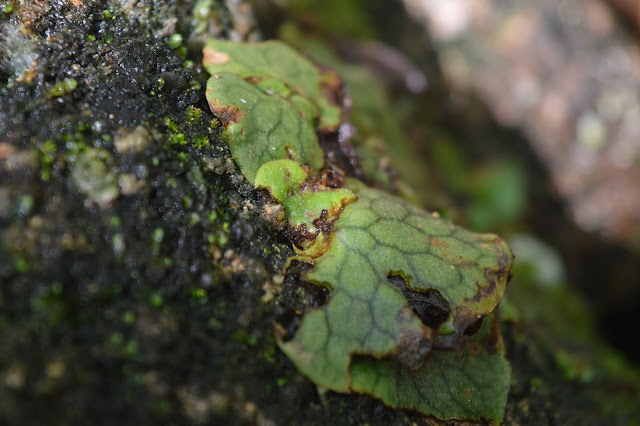 | |
| Eulamprus quoyii is as ubiquitous as ever |
Because of all the rocks, clumped vegetation, and wood piles, Blackmans Gap is absolutely skink central. So far, I've seen Morethia taeniopleura, Carlia pectoralis, Carlia munda, Carlia schmeltzii, Eulamprus quoyii, and a couple Ctenotus. On this trip, however, I found a skink I hadn't previously come across. I think it is a male Carlia rubigo, but I am not sure. The 2015 edition of Wilson and Swann just has a question mark in the general area of Central Queensland, but AROD shows some scattered populations of rubigo in the area, so it could be possible for it to be rubigo. It could also be a juvenile male or a female of another species.
 |
| Not at the sundew bowl. This is down at the main waterhole. The sundews here looked a bit rattier than the ones at the waterfall. |
A couple of weeks later, I went back out for Australia Day, and explored further up the creek into the hills. It was a long trek, climbing up dry waterfalls and stuff, took about 3 hours (uphill) before I had to go home. Only took 20 minutes going back downhill though!
This area is a lot more 'rainforested' along the creek line, with a lot more permanent emergent trees. The vegetation along the main creek at the bottom of the hill is still rainforest-y, but very successional because floods keep washing away and damaging trees.
Away from the creek line, the habitat is a more typical wet sclerophyll/heath sort of composition. I still haven't managed to identify the Banksia species growing there, but I have confirmed that Astrotricha pterocarpa grows there.
It doesn't look it, but that rock face is pretty vertical with very few good safe foot and handholds. A brief heavy shower in the day wet everything to the point where water was trickling down the rock faces, which made it all the more fun to do in thongs.
 |
| Peperomia blanda |
I had just been whinging about the lack of orchids when I turned around from taking photos and saw this really nice Cymbidium madidum on a bottlebrush. This is the first place locally I have seen this species growing wild, so that was really neat. This species has big long spikes of yellow and black flowers that smell like banana lollies.
Up on top of the dry waterfall was an even bigger clump of Cymbidium madidum, with bucketloads of ripening seed pods. This isn't even half of them! It's nice to know that there must obviously be more of them than what we saw.
Right after finding the madidum, I had wished that we would find some tongue orchid. Wham bam thank you maam! Dockrillia linguiformes is one of my favourite native orchids. This patch is about a tenth of what was actually growing on the next rockface up from the madidum. And there was even more past that! It's a weird feeling to describe, when you find something that you read about and is supposedly hard to find in the wild just growing on anything, anywhere. Like you're somewhere really special.
My wishing powers worked again, this time for a type of pencil orchid, Dockrillia bowmanii. This was just a baby, and as we went up the creek, the plants grew in size and number. The stems branch in a really cool way, and hang off the sides of rocks in a messy clump.
I was surprised that we hadn't seen any Dendrobium orchids, but then my prayers were answered by Dendrobium gracilicaule. This was a pretty big clump, with heaps of old flower spikes. I'll have to go back in winter to try and see it in flower.
And to top it all off, some baby elkhorns (Platycerium superbum)!
I'm not actually sure that the plant above is Astrotricha pterocarpa, but the other Astrotricha species that occur locally don't have leaves like that. So who knows anymore. I just think these plants are cool. They are in the same family as umbrella trees, which usually have pretty nifty leaves, but Astrotricha has boring leaves. Astrotricha turns into a big shrubby tree thing with a central stem, and then the flowers come out of the top and in a big spike (technically a panicle) and then the plant dies! It's just different to the things it is related to.
Now that I know about this cool little section, I'm definitely coming back in winter to explore, as the orchids should be flowering by then. I also found some terrestrial orchids, but they are impossible to identify without flowers so that should be good too.
















No comments:
Post a Comment